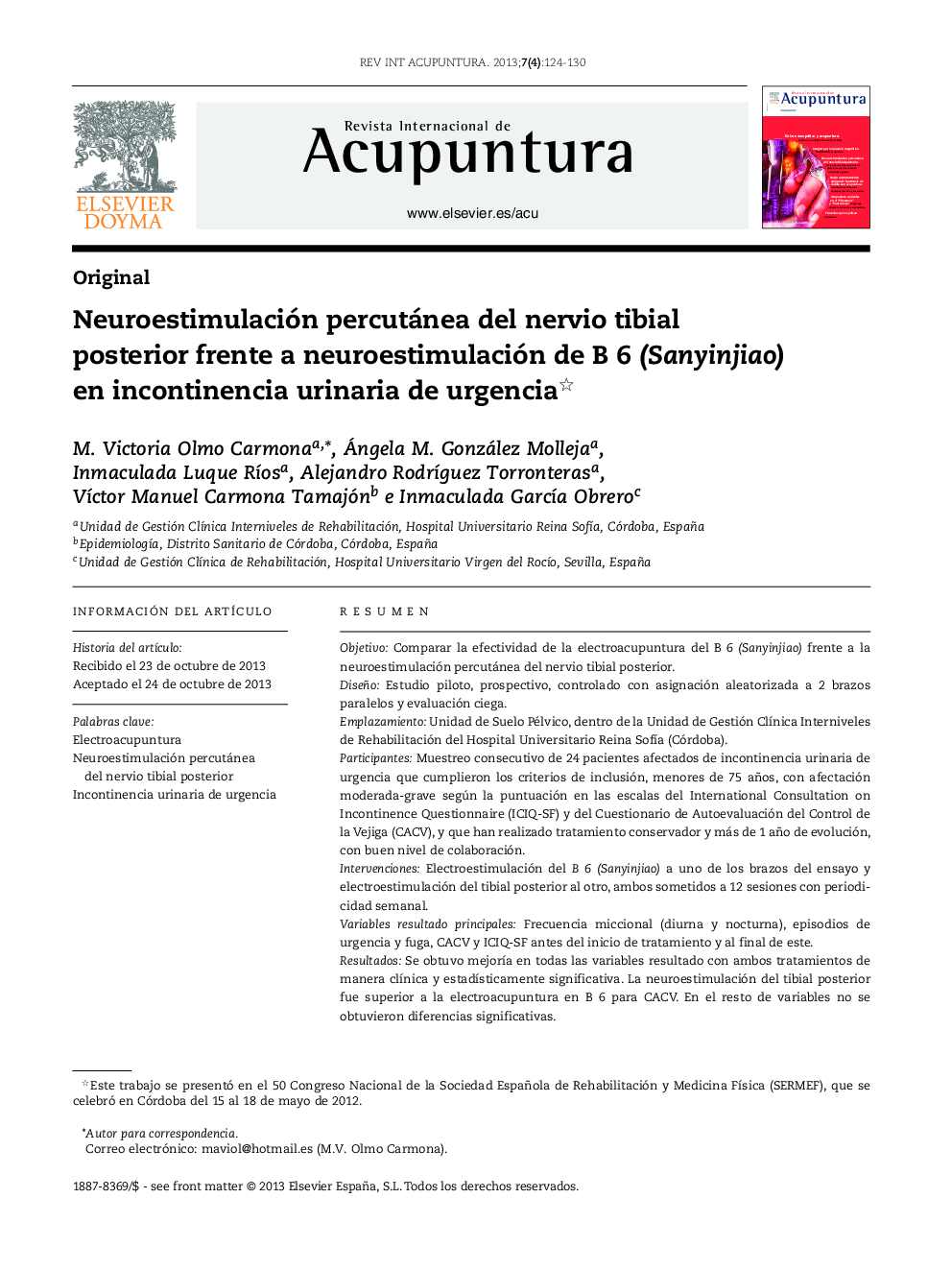| Article ID | Journal | Published Year | Pages | File Type |
|---|---|---|---|---|
| 3102432 | Revista Internacional de Acupuntura | 2013 | 7 Pages |
ResumenObjetivoComparar la efectividad de la electroacupuntura del B 6 (Sanyinjiao) frente a la neuroestimulación percutánea del nervio tibial posterior.DiseñoEstudio piloto, prospectivo, controlado con asignación aleatorizada a 2 brazos parale los y evaluación ciega.EmplazamientoUnidad de Suelo Pélvico, dentro de la Unidad de Gestión Clínica Interniveles de Rehabilitación del Hospital Universitario Reina Sofía (Córdoba).ParticipantesMuestreo consecutivo de 24 pacientes afectados de incontinencia urinaria de urgencia que cumplieron los criterios de inclusión, menores de 75 años, con afectación moderada-grave según la puntuación en las escalas del International Consultation on Incontinence Questionnaire (ICIQ-SF) y del Cuestionario de Autoevaluación del Control de la Vejiga (CACV), y que han realizado tratamiento conservador y más de 1 año de evolución, con buen nivel de colaboración.IntervencionesElectroestimulación del B 6 (Sanyinjiao) a uno de los brazos del ensayo y electro estimulación del tibial posterior al otro, ambos sometidos a 12 sesiones con periodicidad semanal.Variables resultado principalesFrecuencia miccional (diurna y nocturna), episodios de urgencia y fuga, CACV y ICIQ-SF antes del inicio de tratamiento y al final de este.ResultadosSe obtuvo mejoría en todas las variables resultado con ambos tratamientos de manera clínica y estadísticamente significativa. La neuroestimulación del tibial posterior fue superior a la electroacupuntura en B 6 para CACV. En el resto de variables no se obtuvieron diferencias significativas.ConclusionesTanto la neuroestimulación del tibial posterior como la electroacupuntura de B 6 (Sanyinjiao) producen una mejoría en la incontinencia urinaria de urgencia. Los resultados son ligeramente superiores con la neuroestimulación del tibial posterior, sin significación estadística, salvo para CACV, donde la neuroestimulación es superior a la electroacupuntura.
ObjectiveComparison of effectiveness between electroacupuncture of SP 6 (Sanyinjiao) and percutaneous stimulation of the posterior tibial nerve.DesignProspective, blind randomized two-arm controlled pilot study.LocationPelvic Floor Unit, part of the Rehabilitation Interlevel Clinical Management Unit at the Hospital Universitario Reina Sofía (Córdoba, Spain).ParticipantsConsecutive sampling of 24 patients with urge incontinence that satisfied inclusion criteria, under the age of 75, with mild-severe involvement according to the International Consultation on Incontinence Questionnaire (ICIQ-SF) and the Bladder Control Self-Assessment Questionnaire (B-SAQ) and who have undergone conservative treatment for over 1 year, with a good level of collaboration.InterventionsElectrostimulation of SP 6 (Sanyinjiao) to one of the arms of the study, and percuta neous tibial nerve stimulation to the other, both subject to a total of 12 weekly sessions.Main outcome variablesVoiding frequency (diurnal and nocturnal), urge and leaking episodes, B-SAQ and ICIQ-SF results before and after treatment.ResultsA clinical and statistically significant improvement was visible in all outcome variables with both treatments. Results of percutaneous tibial nerve stimulation were superior to those of electroacupuncture of SP 6 for B-SAQ. No significant differences were found for the rest of variables.ConclusionsBoth percutaneous tibial nerve stimulation and electroacupuncture of SP 6 (Sanyinjiao) improve urge incontinence. Results are slightly better with percutaneous tibial nerve stimulation, without statistical significance, where neurostimulation ranks higher than electroacupuncture.
